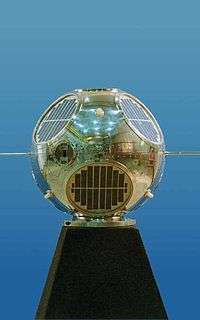Galactic Radiation and Background

Galactic Radiation and Background (GRAB) was the covername for Project Dyno ELINT intelligence satellites operated by the U.S. Naval Research Laboratory (NRL) shortly after the Cold War U-2 incident of 1960. The satellites carried two sets of instruments: an unclassified experiment (called Solrad) and a then-classified payload to collect electronic intelligence (ELINT) (called Tattletale). Of five attempted launches, two missions were successful. The program is also known by the later codeword Canes.[1]
The first GRAB satellite was launched 22 June 1960 on the same rocket as Transit 2A, an early naval navigation satellite. Called GRAB 1, it has the distinction of being the first successful U.S. intelligence satellite, returning intelligence data on 5 July 1960. It collected ELINT information over a period of three months, totaling 22 data collection passes of 40 min each over the Soviet Union, China and their allies. The SOLRAD experiment remained operational for 10 months.[1]
The other successful GRAB mission, called GRAB 2 was launched 29 June 1961, atop the same Thor-Able-Star launch vehicle as Injun, a geophysical science satellite from the University of Iowa, and Transit 4A. GRAB 2 functioned in orbit for fourteen months.
The GRAB program cover was developed after the public disclosure of Project TATTLETALE in the New York Times. TATTLETALE satellites were supposed to obtain radar ELINT information in the S-band using a crystal video receiver derived from the German World War II ATHOS system from a 500 nm circular orbit, and transpond them pulse-by-pulse to ground stations. The ELINT capabilities expanded from one RF band for the first two launch attempts to multiple bands from launch three on.[1] The primary mission was to map the Soviet air defense radars.[2] The existence of the program was declassified by the NRL in 1998. After the establishment of the National Reconnaissance Office in 1962 the program was continued by the POPPY program until its termination on 30 September 1977.
Incidents
During the second launch attempt, the Thor booster shut down 12 seconds early, and the flight was subsequently terminated by Range safety. As fragments fell on Cuba, subsequent launches from Cape Canaveral flew a dogleg trajectory to reach 70 degree inclination.[3]
Launches
.png)
- GRAB 1
- Launch: 22 June 1960
- Site: Cape Canaveral
- Vehicle: Thor-Able-Star
- COSPAR ID: 1960-ETA 2 or 1960-007B(still in orbit as of March 2007)
- (2nd GRAB launch attempt)
- Launch: 30 November 1960
- Site: Cape Canaveral
- Vehicle: Thor-Able-Star (failure)
- COSPAR ID: 1960-F16
- GRAB 2
- Launch: 29 June 1961
- Site: Cape Canaveral
- Vehicle: Thor-Able-Star
- COSPAR ID: 1960-OMICRON-2 or 1961-015B(still in orbit as of March 2007)
- (4th GRAB launch attempt)
- Launch: 24 January 1962
- Site: Cape Canaveral
- Vehicle: Thor-Able-Star (failure)
- COPSAR ID: 1960-F02
- (5th GRAB launch attempt)
- Launch: 26 April 1962
- Site: Naval Missile Facility, Point Arguello, California
- Vehicle: Scout (failure)
- COSPAR ID: 1962-F03
External links
| Wikimedia Commons has media related to SOLRAD program. |
References
- 1 2 3 "History of the Poppy Satellite System" (PDF). National Reconnaissance Office. 2006-08-14. Retrieved 2010-02-28.
- ↑ "The Honorable Peter Teets: National Space Symposium Corporate Dinner Address". National Reconnaissance Office. 2003-04-08. Retrieved 2010-06-04.
- ↑ "History of the Poppy Satellite System - June 2012 release" (PDF). National Reconnaissance Office. 2012-06-06. Retrieved 2012-06-24.
- MacDonald, Robert A. and Moreno, Sharon K. Raising the Periscope... Grab and Poppy, America's early ELINT Satellites. Pub. by NRO, 2005.